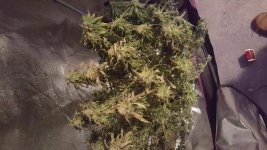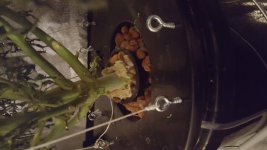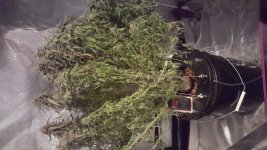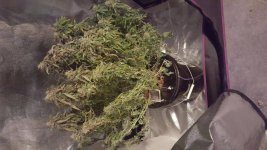-
ICMag with help from Landrace Warden and The Vault is running a NEW contest in November! You can check it here. Prizes are seeds & forum premium access. Come join in!
You are using an out of date browser. It may not display this or other websites correctly.
You should upgrade or use an alternative browser.
You should upgrade or use an alternative browser.
Undergrowth drooping top growth browning and getting crispy!
- Thread starter jman2003
- Start date
Res temps range between 62-68. How do the roots look to you?
62 is too cold. Should not go below 66. White roots are best. Here are some pieces of Snype's RDWC -
Chlorine as a preventative measure
Anyone who doesn’t use live nutrients or supplements in hydroponics, I would advise to keep a residual level of 0.50 PPM Chlorine at all times as a preventative measure against plant pathogens and future root problems. Always remember that too much Chlorine will kill your plants and you never want to put more than 1.0 PPM of Chlorine for large healthy plants. Cuttings and smaller plants are more sensitive to Chlorine and you will want to keep only 0.50 PPM of Chlorine so that you don’t risk killing them. My dropper gives 22 drops / 1 mL of liquid. Before giving Chlorine to small reservoirs you will want to see how many drops per mL your dropper gives so you give a safe amount of Chlorine. My dropper gives a 0.50 PPM of Chlorine at the rate of 1 drop of Clorox Bleach / 2 Gal. To give 0.50 PPM of Chlorine using Clorox Bleach, the equation is 1 mL of Clorox Bleach / 44 Gallons. Always take into account if your tap already has Chlorine in it and adjust your equation. Remember in a well aerated solution, Chlorine naturally disappears in 3-4 days so add in your Chlorine every 4 days as a preventative measure against future root and pathogen problems. Add this to your normal schedule and you will see how hard it is to get root problems again.
pH
pH is very important when you are growing cannabis. Growing cannabis in soil and growing plants hydroponically require totally different pH’s so don’t be confused by this. I will only talk about pH in RDWC with hydroton as a medium here. You want to stay in a range of 5.8 – 6.2 at all times. Falling below or above this mark can cause serious problems. If your solution is not pH’d to the correct numbers, then the plants will not be able to receive and use the nutrients that you are supplying to them.
I have a lot of experience with many company's pH and TDS / PPM meters. When you buy one of these devices from a grow shop it usually means that you did not buy an expensive lab grade model and the result is that your device is made with cheaper components. I understand that most growers don't have thousands of dollars to buy a lab grade meter and this is ok but there are some things that you must know. With my testing with Hanna, Nutradip and Blue Lab I see similar problems in them that can give you a false reading.
Just because you might have a top of the line pH meter (pH meter is a necessity in hydroponics) doesn’t mean that the reading that it is giving you is correct. There are a few factors that will give you a false reading. Here is a list:
1. Your calibration solution is contaminated, old or was stored in high temperatures or exposed to light for too long.
2. There is a build up of gunk on the pH probe. Solution: Gently clean the probe with a soft brush and recalibrate.
3. pH probe is broken or it’s beyond its life span. Buying pH meters at grow shops is an economical way of acquiring a meter but it is not lab grade and cheaper components are used in the process. pH probes can damage very easily and are also sensitive. When the pH probe is not being used, it is very important to keep it in 7.0 calibration solution. When you open the box for the first time from buying the meter, there is not always solution attached to the bottom of the probe but it is dipped in some sort of salt so don’t be confused by this and think that you can store your probe without solution. Your probe will eventually dry up and break if you were to dry it out. It is very simple to know if you have a damaged probe. This process will require 2 different calibration solutions (pH 4, pH 7 or pH 10). Most meters that I’ve seen in the US use pH 4 and pH 7. Your owner’s manual will tell you if you have to use the 7 or the 4 first. It is important to listen to what the company of the specific meter that you have tells you. If your meter does not contain a computerized calibration method then you will see that you calibrate it with a screw driver or there are knobs that you turn or you may have to digitally punch in numbers to a screen on your device. If your meter calibrates to a screw driver or some sort of knob that you turn then it is important for you to know that when you pH the 4 first and finish, you then clean the probe and insert it into the pH 7 calibration solution. If you insert the probe into the 7 and it doesn’t read pH 6.8, 6.9, 7.0 or 7.1, 7.2 (normally I wouldn’t insert the 6.8 or 7.2 in here but the meters at grow shops are not lab grade and have a greater margin of error), then your probe has gunk on it or is broken and needs to be replaced. You can try to recalibrate it but it will not work because it will move the pH 4 somewhere else and you’ll keep going back and forth just wasting time. You will usually have to do some tweaking going back and forth between the pH 4 and 7 solution because there is a lot of little spaces between 4.0 - 4.1 and 3.9 - 4.0 as well as 6.9 – 7.0 and 7.0 – 7.1. Once you get the meter to read 4.0 and 7.0, then your meter will be accurate for at least that usage but you should calibrate your meter once a week to be safe. Your meter is a computer and you can’t just trust the numbers that it is spiting out at you. Always question the reading that you are getting and compare it to what your plants are telling you. The first signs that you will usually see first, if your probe goes out of alignment, is yellowing of the edges of fan leaves (Magnesium Lockout) or brown / black spots on leaves (Calcium Lockout). If you have the solution up to the required PPM and you see these signs on the leaves, then that should be a big read flag and will require you to calibrate your probe or check if it is broken and get a working one. You will notice within a period of time, the pH of your solution will fluctuate. Depending on what different things that you add to your Rez can make the fluctuation different so if your solution normally rises and then you add something else to the mix and then it does the opposite then it’s good to keep this in mind. If you know that your solution rises, then set your solution to 5.8 and let it climb to 6.2 and then pH it down, if your solution falls, then set it to 6.2 and let it fall down to 5.8 and pH it back up. This fluctuation should not peak within a 24 hour period with most nutrients so if you see this happen you most likely have root problems (root rot / pythium) or some sort of pathogen, fungus or algae. We will cover this in another chapter.
4. RF interference from your digital/electronic ballast. RF interference has a major affect on many pH / TDS / PPM meters that are sold at grow shops. It is important that your ballasts and any equipment that gives off RF is turned off before calibrating and using your meter. I have spent countless hours on the phone with the owners of these company's complaining about how the RF interference from my ballasts are affecting my reading and they would send me brand new meters that would have the exact same problem. Make sure all your equipment is turned off when using your meters.
Feeding
Variety of strains requires different amounts of nutrient levels. This is why you wouldn’t want to grow multiple types of strains in the same system at the same time. If you have some heavy feeding strains mixed with underfeeding strains, it would be impossible to meet the needs of both types at once. For this purpose, it is always best to have all your plants in each system from the same mom in clone form. Of course you can grow similar feeding strains together but you would not maximize the yield of the grow and this is about maximizing your grow.
Overfeeding can cause lack of flavor in your final product and usually does. I will explain how to learn what your plants want by using your EC/TDS/PPM meter. Having one of these meters is a necessity when growing hydroponically and if you don’t have one you are flying blind. Always make sure that your meter is calibrated and that you check re-calibrate the meter every 2 weeks and when you see potential problems going on. Most grow shop meters are made with cheap components and are not lab grade so reading can be off frequently throughout your grow.
I believe in growing in sterile growing systems at all times. This doesn’t mean that growers who do use live nutrients or suppliments are wrong but this isn’t what this manual is about. Things can go wrong real fast in hydroponics and potentially kill your whole crop within days. Because of this I use refined nutrients and the brand that I like to use is General Hydroponic Flora Series. I enjoy the results that I get with this product but I mainly use it because I can keep my pH more stable with it compared to some other brands. Whatever brand you choose you will notice how the pH acts and if it swings too much you can try another brand and see what works for you. When I use GH Flora, I only use the Micro and the Bloom. The Micro has all the nitrogen that you need in your grow. 1 part micro to 1.5 parts bloom for VEG stage and 1 part Micro to 2 part Bloom for Flowering stage. You will first have to test all your clones in the same system to see how these plants eat so you can maximize the yield without burning them and ruining your flavor. The way that I do this with my nutrients is once I have roots, I start with a low PPM around 300. I keep data and write down what the PPM is every day once I top off the rez to the same point that it was when I first put the nutes in when it was 300. What I want to see is the PPM come down but not real fast. If your meter is reading 240 in 3 days then I would raise the solution to 360 and continue to record this data. I know that I am where I want to be when the meter is only going down 010 ppm per day. I like to look over a 3 day period cause it is hard to see 10-20 PPm per day as opposed to 60 ppm over a 3 day period. If the PPM is not going down then you are too high so when you raise it you don’t want to go too high or you’ll have to change out your system and nute at a lower level. As your plants are growing, you are recording the data that you get and when it reaches the levels of 10-20ppm of a decrees per day, then you know how much to use on your future grows with that pheno.
Throughout the years I’ve learned to keep it as simple as possible and don’t be fooled by variety of high priced snake oils that the grow shop has to offer. Cannabis doesn’t require as much as most growers think and a lot of new growers and even people who have years of growing experience make the mistake of following the directions on nutrient bottles. This can fry your plants.
I can not find Snype's thoughts on temp, but 68 to 70 is ideal. Above 72 Dissolved oxygen is reduced, and below 66 the plants think winter is coming, and slows metabolism.
Tons of info there loc. I also try to keep it simple. I usually go half strength on the nutes. I went full strength with the holidays assuming plain water top offs would cut it. I guess my assumption is kicking me in the butt. Hows the saying go dont assume because it makes an ass of me and you? Well at least it makes me an ass. Thanks loc for the response once again. I look forward to hearing from you again.
Tons of info there loc. I also try to keep it simple. I usually go half strength on the nutes. I went full strength with the holidays assuming plain water top offs would cut it. I guess my assumption is kicking me in the butt. Hows the saying go dont assume because it makes an ass of me and you? Well at least it makes me an ass. Thanks loc for the response once again. I look forward to hearing from you again.
Snype is a perfectionist. I changed my one post. It is one drop per gallon for bleach. Actually almost all bleach now is super bleach and a little stronger. To be safe, might want to use 3 drops to 5 gallons.
I have never seen a PPM meter that can measure .5 of a PPM. Here is something from another very good post -
Root Rot
What causes root rot? Low Oxygen levels. (DO) Desolved Oxigen. Temp's are the main reason for root rot, Low temps will lower the DO levels and high temps will cause low DO levels. Keeping temps between 65 to 72 will allow MAX DO levels or max o2 for roots. (Thank you so much for the information syko2! has provided above!)
Over watering also causes root rot, Root Rot infects parts of the roots, which then spread infecting the whole roots causing death, Root Rot can be caused by to high of temps in hydro as well as over watering. Not enough drainage in your soil can cause Root Rot, even signs of it looking over watered, because the soil holds moisture to long for the roots to dry out. So these 3 things are all connected together. The main one that causes everything is over watering. Once you find out you have root rot, depending on how bad the problem is, you can add H202( Hydrogen Peroxide) with your water or hydro setup to kill the bacteria caused from root rot. If the plant is severely taken over by it, there are only a few things you can do, cut off the roots affected by it depending on if its hair roots or tap roots, use H202 mixed with water in a different bucket and use it for a dip to help kill off bacteria before putting it back in the system, also note the system needs to be cleaned out if you have root rot.... using products like sm90 will kill off the root rot, using h202 in your system does more harm than good, it kills off the bad bacteria and good thus creating a worse off problem after the h202 has been overran, h202 if used in a hydro/aero system must be replaced everyday due to it disapating from the air. After it disaptes the plants defensive system has been killed off by the h202 causing the root rot that was not killed by the h202 left and thus overruns the plants root system. So again h202 should never be used in the hydro system, be kept in the system, although it is safe to use to rid of algae growth in rockwool and other mediums, but never be used in with the root zones regularly. Sm90 is a good product you can use to kill off root rot. Hydroguard helps protect and there are many other products that work as well, hydroguard is one of the more popular ones that work.
To prevent Root Rot, adding product's like Thrive Alive B-1, See Weed, Super thrive will help protect your plant's from root rot and will help cure root problems. ( Again ty so much for giving me the info syko2!!!)
Here is the entire thread -
https://www.icmag.com/ic/showthread.php?p=163836&highlight=chlorine#post163836
So you think i should try some bleach in the res? How do the roots look to you? Theres different kinds of bleach which sjould i do? Oxiclean or bleach to clean my white shirts? Two very different bleaches. What about H2o2?
I do not want to give bad advice, and kill your plants. I would add 1 drop per gallon of plain old laundry bleach. Preferably not ultra bleach. If ultra, add 3 or 4 drops per 5 gallons. I would do google searches on bleach for DWC and hydrogen peroxide for root rot. Here are some youtube videos -
https://www.youtube.com/results?search_query=hydrogen+peroxide+for+root+rot
I have no idea how much hydrogen peroxide to use. It seems from the one guys post, they should be dipped in hydrogen peroxide and water (no idea what ratio), then go back into cleaned DWC bucket.
How do my roots look to you?
I have not done hydro in about 4 years. I had problems, then ran heisenberg tea all the time, which gave pure white roots. Certain products like Floralicious can cause dark roots.
I would hope someone else chimes in on how they look. If they smell, are slimy, or fall of easily, then it is bad. My current young plants have pure white roots. I have temps at 68, and add bleach to the water occasionally. I stockpile RO water in my office, and whenever the surface looks a little funky, I add 2 or 3 drops per gallon. I use that water to top off reservoir, in aeroponic system.
I will be putting my RDWC system together over the next week.
Is the water clear or mangy?? The guide to sick plants by mynameis stitch, that I posted link a few posts back, has pictures of root rot/pythium, towards the bottom.
With your PPM that high, its more likely over fertilization than a deficiency. I would only give water for a couple days and give them more like 500 ppm till you see some recovery.
MO on the roots, I use floralicious plus and it dyes my roots too. I touch them, they shouldn't break easy or feel slimy at all.
MO on the roots, I use floralicious plus and it dyes my roots too. I touch them, they shouldn't break easy or feel slimy at all.
HarvestMoon303
Active member
Have you been feeding roughly the same each time? If you've been running the same PPM for this plant's entire life, I would highly doubt that it just all of the sudden started being too hot for the plant. It looks a lot like Fusarium Wilt to me.
svnfingerblades
Member
sounds like hydro is a PITA
GAME OVER
GAME OVER
i think its pretty much dead. It smells like hay and the buds are getting crispy now. Should i just chop it and hang it? I feel like a real ass.
GAME OVER
i think its pretty much dead. It smells like hay and the buds are getting crispy now. Should i just chop it and hang it? I feel like a real ass.
Attachments
The only reason to save it at this point is for learning purposes, so if it happens in future, you know what to do, and what products to have on hand. I have hundreds of dollars worth of products I have never even opened, due to losing plants to bud rot, spider mites, thrips, and broad mites. It is nice to have them for peace of mind.






